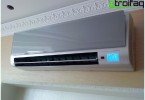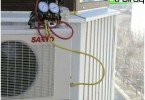Air conditioning systems
It is possible to maintain the microclimate in the room, ensuring compliance with the given parameters using a whole range of technical means, combined under the general name “air conditioning system”. Modern air conditioning systems are very diverse in technical specifications and design variations. The general purpose is to create and maintain the necessary air parameters (the list of parameters depends on the type of system, among others, air purity, temperature, speed, relative humidity). We will briefly review the varieties of air conditioning systems to identify the main features and familiarize themselves with the technical characteristics..
Content
- Air conditioning classification
- Comfortable and technological systems – reveal the difference
- More about domestic air conditioners
- Features of technological systems
- Getting to know precision conditioning
- Air conditioning chiller-fan coil
- Characteristics of central air conditioning systems
Air conditioning classification
- According to the destination (for comfortable and technological).
- By capacity (domestic and commercial).
- By device (multizone, precision, chiller-fan coil systems, central, roof, cupboard).
Comfortable and technological systems – reveal the difference
Comfortable air conditioning systems are designed to create and maintain the necessary microclimate conditions in the premises. Such systems are domestic and commercial. There is no clear distinction, just in everyday life, as a rule, air conditioners of lower performance are used.
More about domestic air conditioners
Domestic air conditioners are single and multi-unit. In single-unit air conditioners, all nodes are assembled in one housing. An example would be window and mobile models. Multiblock systems are composed of two (split systems) and more (multi split systems) buildings. Simple split systems consist of external and internal blocks. The outdoor unit contains a condenser, a refrigerant transfer pump and a fan. The evaporator, fan and condensate collector are located in the indoor unit. Both units are interconnected by a freon highway and control wires.
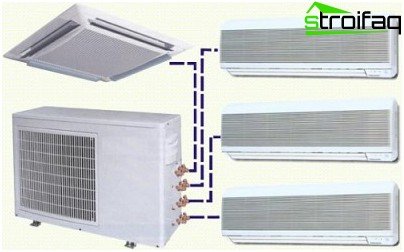
The powerful outdoor unit of the multi split system provides the operation of several indoor units
The advantage of single-unit air conditioners is the ease of installation that does not require third-party highly qualified assistance, and the main disadvantage is the high noise level. Installation of air conditioning systems based on split systems is much more expensive, requires the participation of specialists with high-tech equipment. As for the features of work: split systems are almost silent, their cooling capacity is several times higher than the power consumption.
Timely maintenance of air conditioning systems of this type (cleaning or replacing the filters of the indoor unit, protecting the outdoor unit from freezing in the winter) guarantee a long uninterrupted operation. Multi split systems consist of one powerful outdoor unit and several (up to seven) indoor units. Such a device makes it possible to serve several rooms at relatively low energy costs. Most often, air conditioning of an apartment or cottage is carried out precisely by installing a split system of the required power. Commercial air conditioners are characterized by high performance, it is also a kind of split systems. Depending on the device method of the indoor unit, there are channel, cassette, ceiling, column.
Features of technological systems
Technological air conditioning systems provide optimal conditions for the passage of technological processes and the smooth operation of various devices. Such systems are used, if necessary, the temperature and moisture content of the raw materials are constant (for example, in the food industry, various laboratories), maintaining the relative humidity in the prescribed framework (for example, to exclude the possibility of accumulation of static electricity when working with explosive atmospheres).
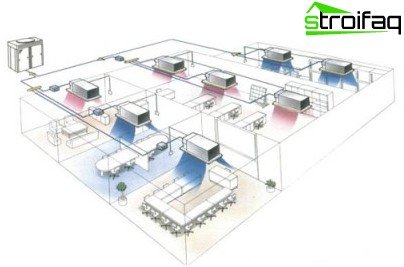
Especially useful is the use of a multi-zone system in buildings where air conditioning of rooms with varying degrees of heat load is necessary.
Multizone conditioning systems provide simultaneous service of several zones. In multi-zone systems, it is possible to connect up to 40 indoor units to one external. Moreover, indoor units can vary not only in power, but also in design (floor, wall, floor-ceiling, duct, etc.); simultaneous operation of various units in cooling or heating mode is also possible. A qualitatively strong side of such systems is that the distance from the outdoor to the indoor unit can be up to 150 m at the same level, and vertically up to 50 m, without compromising performance. Such systems are economical and suitable for buildings of any architectural complexity..
Getting to know precision conditioning
In conditions requiring special accuracy of compliance with the given microclimate parameters, precision conditioning is necessary. We are talking about the continuous provision and maintenance of air purity, the necessary humidity, temperature (with an accuracy of 1 degree).
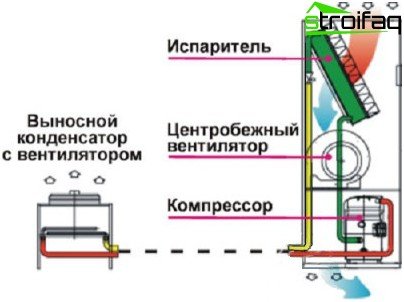
Schematic of a precision air conditioner with lower air distribution and a remote condenser
For example, a precision air conditioning system ensures uninterrupted operation of the equipment of computer centers, mobile operators, pharmaceutical laboratories. An air conditioner that guarantees high accuracy of microclimate indicators, usually two-unit, contains a condenser and a fan in the external unit, an automation system in the internal unit, a humidifier, a compressor, an evaporator and a fan. This type of air conditioner can supply air through the bottom panel (through the raised floor air distribution space).
Air conditioning chiller-fan coil
The system is fundamentally different from the rest using antifreeze or water as a refrigerant for inter-unit heat transfer.
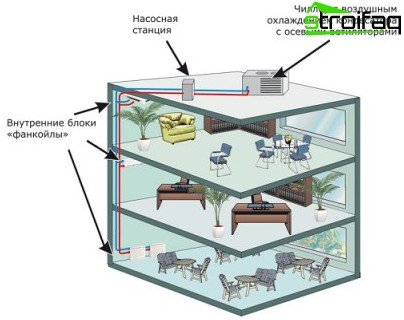
In this air conditioning system, the distance between the units can reach up to 50m in height
The chiller is an outdoor unit of the system, it is a refrigerator that cools water, which enters the fan coil through heat-insulated pipelines. A pump station is used to circulate water through the system. By their purpose and device, fancoils resemble indoor units of split systems, are installed inside the serviced premises, contain a heat exchanger, fan, filter and control unit.
System benefits
- the maximum distance between the blocks and the number of fan coils is practically unlimited, it depends only on the power of the pumping station and the performance of the chiller used;
- there is no need to use expensive copper pipelines, they can be steel or PVC;
- the power range of the produced chillers is 5–9000 kW, which allows using these systems to condition the cottage, multi-apartment building or industrial premises.
Characteristics of central air conditioning systems
Central air conditioning systems are multifunctional complexes located in a separate building premises or in a separate building, air conditioning design in this case occurs at the design stage of the building itself. Each air conditioning project, in addition to finding the best technical solution, includes the design of ventilation system circuits and the location of the elements of the air conditioning system.
Obviously, air conditioning in indoor concert halls or stadiums is done using more powerful devices than those used to maintain the microclimate in a cottage or ordinary city apartment. Only a responsible approach already at the stage of system design, purchase of all components, installation and competent operation guarantees high efficiency of the air conditioning system.





